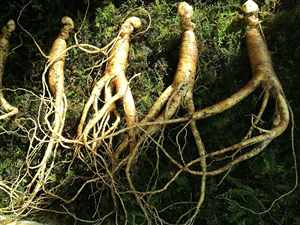Ginseng (Panax quinquefolius, T. ginseng)
Main Facts about Ginseng

Using Ginseng
Ginseng root, Asian and American, is known as the ultimate adaptogen. Adaptogens help the body to cope with non-specific, chronic stress, the type we commonly associate with modern life. American Ginseng rebuilds vitality, increases stamina and endurance and promotes deep, sound sleep. Rather than the warming, drier energy of Asian Ginseng, American Ginseng is a cooler, moisturizing tonic. While Chinese Ginseng is usually reserved for recuperation and building, American Ginseng can be used in hotter conditions to allay thirst, moisten, and revitalize the body. Laboratory studies in animals have found that American ginseng is effective in boosting the immune system, and as an antioxidant. In theory, this improvement in immune function could help the body fight off infection and disease. Other studies show that American ginseng might have therapeutic potential for inflammatory diseases. Several human studies found that American ginseng lowered blood sugar levels in people with type 2 diabetes. American ginseng has been shown to inhibit tumor growth. In one laboratory study on colorectal cancer cells, researchers found that American ginseng possessed powerful anti-cancer properties. One preliminary study suggests that American ginseng, in combination with ginkgo (Ginkgo biloba), may help treat ADHD.Caution!
Taking too much over time can lead to overstimulation. Do not take if pregnant, breastfeeding, or if you have high blood pressure. Individuals requiring anti-coagulant therapy such as warfarin should avoid use of American ginseng. Not recommended for individuals with impaired liver or renal function. Other adverse effects include: headaches, anxiety, trouble sleeping and an upset stomach.Cooking with Ginseng
Leaves can be used also, but root is most powerful. It is a perfect tonic herb for the summer months and can be taken with other adaptogens and tonics or added to cooling drinks.How to grow Ginseng
Ginseng is found in rich shaded forests with loamy soils and heavy canopies. The plant grows wild in the northern and central United States, as well as in parts of Canada. It is cultivated in the United States, China, and France.| Ginkgo biloba |
Goldenseal
|